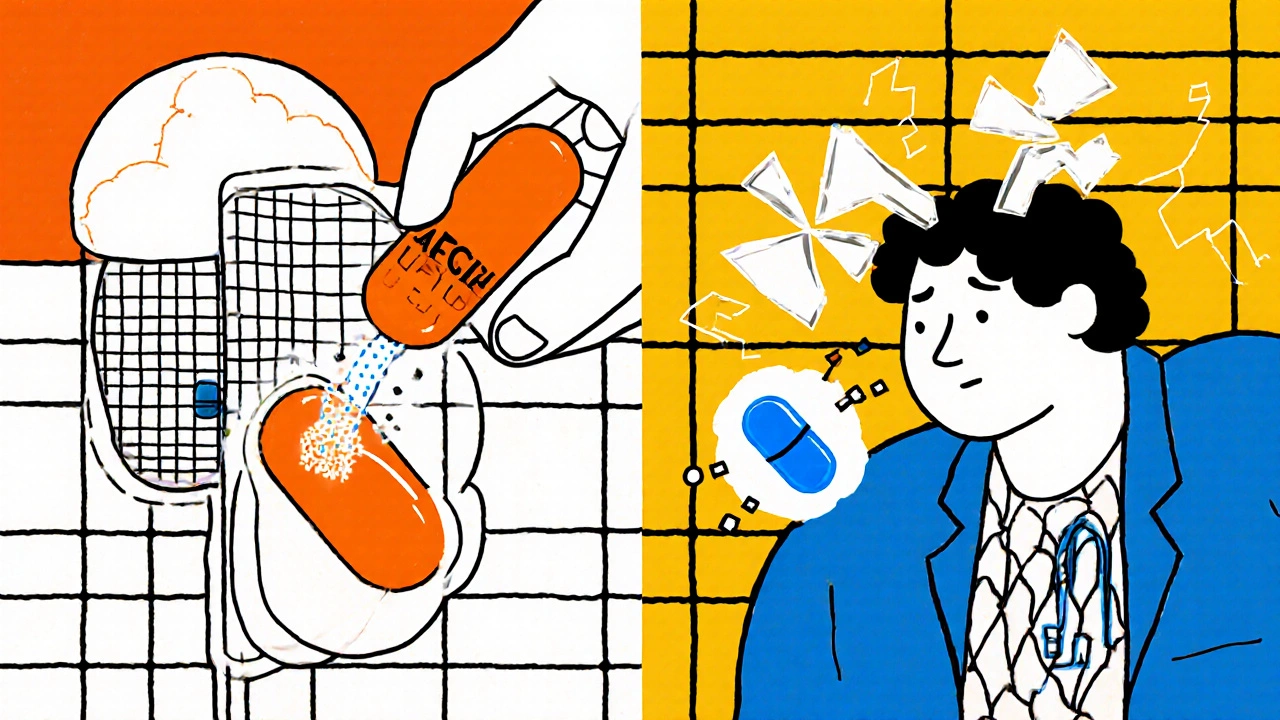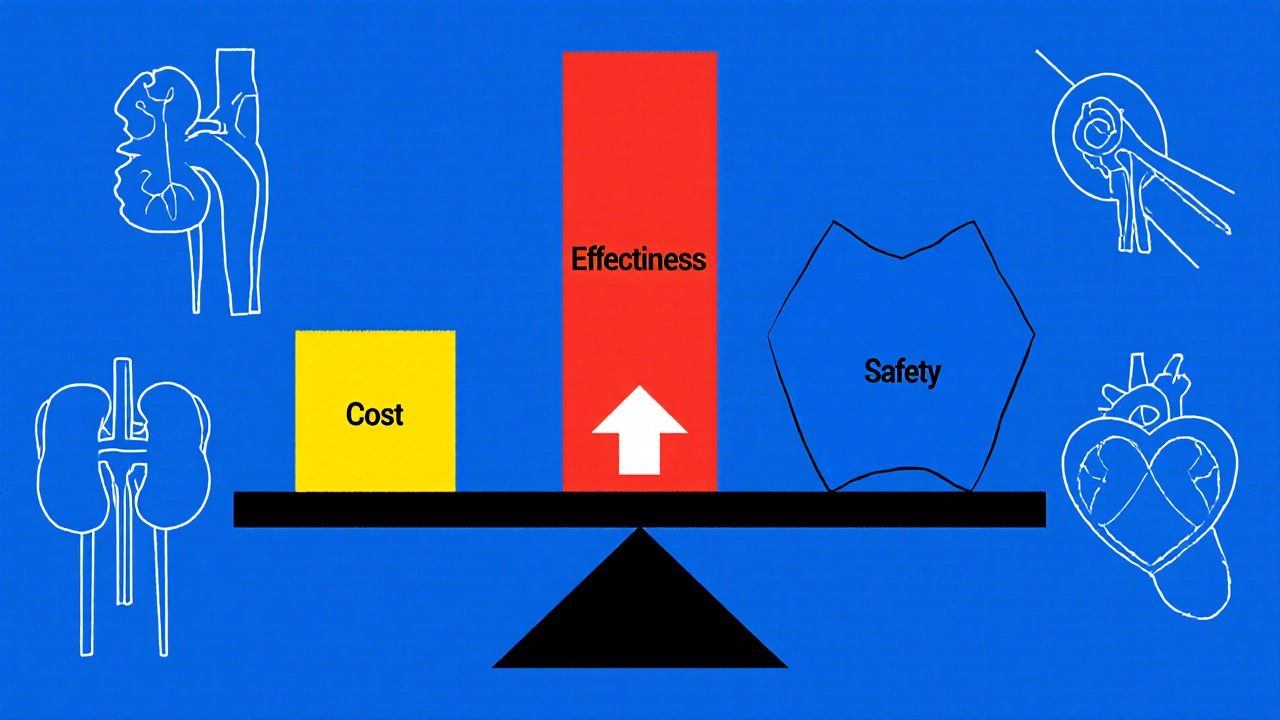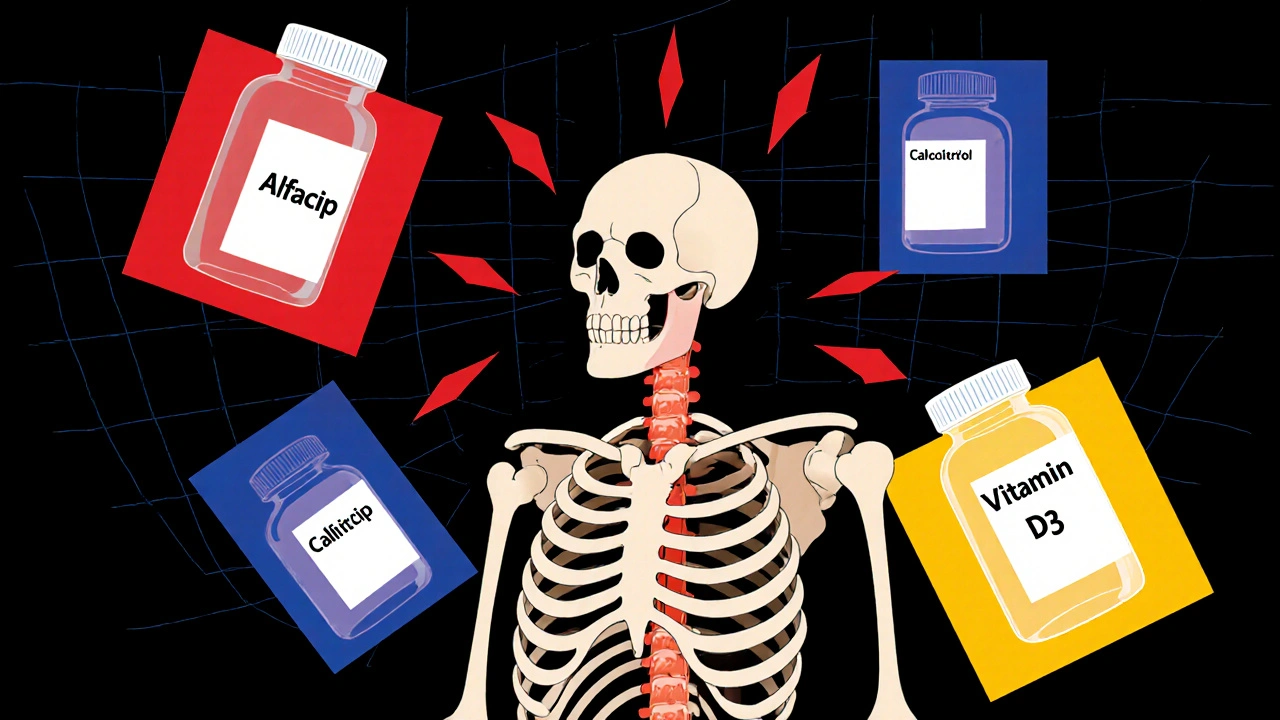Vitamin D Therapy Selection Tool
Personalized Vitamin D Therapy Guide
Select your current health parameters to see which vitamin D therapy option might be most appropriate for your situation. This tool is based on the information in the article and should be used as a general guide. Always consult with your healthcare provider before making changes to your medication.
Recommended Therapy
Important Safety Information
How This Recommendation Was Made
When your body struggles to process vitamin D properly-whether due to kidney disease, osteoporosis, or parathyroid issues-Alfacip (alfacalcidol) is often prescribed. It’s not just another vitamin D pill. It’s an active form your body can use right away, skipping the usual liver and kidney steps. But is it the best option? And what happens if it doesn’t work for you, or costs too much, or causes side effects? You’re not alone in asking these questions. Many people switch between Alfacip and its alternatives, trying to find what fits their body, budget, and lifestyle.
What is Alfacip (Alfacalcidol) and how does it work?
Alfacip is the brand name for alfacalcidol, a synthetic form of vitamin D that the body converts into calcitriol, the active hormone that regulates calcium and phosphate levels. Unlike regular vitamin D3 (cholecalciferol), which needs two rounds of activation in the liver and kidneys, alfacalcidol only needs one-usually in the liver. This makes it faster-acting and more reliable for people with kidney problems.
It’s commonly used for:
- Chronic kidney disease (especially stages 3-5)
- Postmenopausal osteoporosis
- Hypoparathyroidism
- Rickets and osteomalacia
Typical doses range from 0.25 to 1 microgram per day, taken orally. Blood calcium levels must be monitored regularly-too much can cause hypercalcemia, leading to nausea, confusion, or kidney stones. That’s why doctors don’t hand this out like regular supplements.
Common alternatives to Alfacip
There are three main alternatives doctors consider when Alfacip isn’t suitable:
- Calcitriol (brand names: Rocaltrol, Calcijex)
- Cholecalciferol (Vitamin D3)
- Paricalcitol (Zemplar)
Each has different strengths, risks, and use cases. Here’s how they stack up.
| Medication | Active Form | Activation Required | Best For | Typical Dose | Cost (AUD/month, approx.) | Key Risk |
|---|---|---|---|---|---|---|
| Alfacip (alfacalcidol) | 1-alpha-hydroxyvitamin D3 | One step (liver) | Kidney disease, osteoporosis | 0.25-1 mcg/day | $25-$40 | Hypercalcemia |
| Calcitriol | 1,25-dihydroxyvitamin D3 | None (already active) | Severe kidney failure, hypoparathyroidism | 0.25-0.5 mcg/day | $50-$80 | Higher hypercalcemia risk |
| Cholecalciferol (Vitamin D3) | Pre-hormone | Two steps (liver + kidneys) | Mild deficiency, general health | 1,000-5,000 IU/day | $5-$15 | Too slow for kidney patients |
| Paricalcitol | Modified vitamin D analog | One step (liver) | Kidney disease with high PTH | 1-4 mcg, 3x/week | $120-$200 | Less hypercalcemia risk |
When is calcitriol a better choice than Alfacip?
Calcitriol is the fully active form of vitamin D. It doesn’t need any conversion at all. That makes it ideal for people with severe kidney failure where even the liver’s ability to activate alfacalcidol is compromised.
Studies from the Journal of the American Society of Nephrology show calcitriol reduces parathyroid hormone (PTH) levels more predictably than alfacalcidol in dialysis patients. But it also raises calcium levels faster. If your calcium is already borderline high, calcitriol could push you into dangerous territory. That’s why doctors usually start with Alfacip and only switch to calcitriol if PTH stays high after 3-6 months.
Another difference: calcitriol is often given as an injection in hospitals, while Alfacip is almost always oral. For home use, Alfacip wins on convenience.
Why vitamin D3 isn’t always the answer
Many people assume popping a cheap vitamin D3 supplement (1,000-5,000 IU) is enough. But if your kidneys can’t convert it, you’re just wasting money. A 2023 study in Clinical Kidney Journal found that 68% of patients with stage 4 kidney disease had no improvement in calcium or PTH after 6 months on vitamin D3 alone.
Vitamin D3 is great for:
- People with sunlight deficiency
- Those with normal kidney function
- General bone health maintenance
But if you’ve been diagnosed with renal osteodystrophy or secondary hyperparathyroidism, vitamin D3 won’t fix the problem. It’s like trying to start a car with a dead battery-you need the right kind of power, not just more fuel.

What about paricalcitol?
Paricalcitol (Zemplar) is newer and designed specifically for kidney patients. It’s a synthetic analog that suppresses PTH without raising calcium as much as calcitriol or alfacalcidol. That’s a big deal-because high calcium leads to heart and blood vessel damage over time.
A 2022 meta-analysis in BMJ Open showed paricalcitol reduced cardiovascular events by 18% compared to calcitriol in dialysis patients. But it’s expensive. In Australia, a month’s supply can cost over $150, even with PBS subsidy. Most patients only get it if:
- Alfacalcidol failed to control PTH
- They keep developing high calcium levels
- They’re at high risk for heart disease
It’s not a first-line option. But for some, it’s the only safe long-term solution.
How to decide which one’s right for you
There’s no one-size-fits-all. Your doctor will consider:
- Your kidney function (eGFR number)
- Your serum calcium and phosphate levels
- Your PTH (parathyroid hormone) levels
- Whether you’re on dialysis
- Your cost and insurance coverage
Here’s a simple decision flow:
- If your kidneys are mildly impaired (eGFR 30-59) and calcium is normal → Start with Alfacip.
- If your PTH stays high after 3 months on Alfacip → Switch to calcitriol or paricalcitol.
- If your calcium keeps rising → Try paricalcitol.
- If your kidneys are healthy but you’re vitamin D deficient → Use vitamin D3.
- If you’re on Medicare or PBS → Check which drugs are subsidized. Alfacip is usually covered; paricalcitol needs prior approval.
Don’t switch on your own. Even small changes in dose can cause dangerous spikes in calcium. Always get blood tests before and after switching.
Side effects and what to watch for
All these medications carry the same major risk: hypercalcemia. Symptoms include:
- Feeling nauseous or vomiting
- Excessive thirst or frequent urination
- Muscle weakness or confusion
- Bone pain
If you notice any of these, stop the medication and call your doctor. A simple blood test can confirm high calcium. In severe cases, you may need IV fluids or even hospitalization.
Less common side effects:
- Headache (common with calcitriol)
- Itching or rash (rare)
- High phosphate levels (if you’re not taking phosphate binders)
Always take these meds with food for better absorption. Avoid calcium-rich antacids like Tums unless your doctor says it’s okay.

Real-world experience: What patients say
From feedback on Australian patient forums and pharmacy surveys:
- “Alfacip worked fine until my calcium went too high. Switching to paricalcitol was a game-changer.” - Margaret, 68, Sydney
- “I was on calcitriol for a year. Felt great until I started getting kidney stones. Now I’m on Alfacip at half the dose.” - Tom, 72, Brisbane
- “I tried vitamin D3 for six months. My PTH didn’t budge. My doctor said it was useless for me.” - Linda, 59, Melbourne
These aren’t just anecdotes. They reflect real clinical patterns. What works for one person may not work for another-even if their diagnosis is the same.
Final thoughts: It’s not about the cheapest option
Alfacip is often the best starting point. It’s effective, affordable, and widely available. But if it’s not working-or if it’s causing side effects-don’t stick with it out of habit. Calcitriol, paricalcitol, and even vitamin D3 each have their place. The goal isn’t just to take a pill. It’s to protect your bones, your heart, and your kidneys over the long term.
Ask your doctor: “What’s my calcium and PTH level? Is this medication helping, or just filling a prescription?” That’s the real question behind every switch.
Can I switch from Alfacip to vitamin D3 on my own?
No. If you have kidney disease or parathyroid issues, vitamin D3 won’t work the same way as Alfacip. It needs to be activated by your kidneys, which may not function properly. Switching without medical supervision can lead to worsening bone disease or dangerous calcium imbalances. Always consult your doctor before changing medications.
Is Alfacip better than calcitriol for osteoporosis?
For postmenopausal osteoporosis with normal kidney function, Alfacip and calcitriol are equally effective at improving bone density. But Alfacip is usually preferred because it’s less likely to cause high calcium levels. Calcitriol is typically reserved for people with kidney problems who also have osteoporosis.
Does PBS cover Alfacip and its alternatives?
Yes, Alfacip (alfacalcidol) is listed on the PBS with a subsidy. Calcitriol is also covered, but paricalcitol requires special approval from Medicare. Costs vary depending on your eligibility. Always check with your pharmacist or use the PBS website to confirm current pricing and restrictions.
How long does it take for Alfacip to work?
You may see changes in calcium levels within 1-2 weeks. But it takes 3-6 months to see improvements in bone density or PTH levels. Blood tests every 4-8 weeks are needed to adjust your dose safely. Don’t expect immediate results-this is a long-term treatment.
Can I take calcium supplements with Alfacip?
Yes, but only if your doctor recommends it. Many people on Alfacip also need calcium supplements to support bone health. But taking too much calcium together can raise your blood calcium to dangerous levels. Your doctor will check your levels and adjust both your Alfacip dose and calcium intake together.
Are there natural alternatives to Alfacip?
There are no natural alternatives that can replace Alfacip if your body can’t activate vitamin D properly. Sunlight, diet, and vitamin D3 supplements won’t work if your kidneys are damaged. Alfacip is a prescription medication for a specific medical condition-not a general supplement. Don’t rely on herbs, oils, or diets to treat conditions like renal osteodystrophy.
Next steps if you’re on Alfacip
Here’s what to do right now:
- Check your last blood test results-especially calcium, phosphate, and PTH.
- Ask your doctor: “Is Alfacip still the right choice for me?”
- Review your monthly medication costs. Are you paying more than you need to?
- Make sure you’re not taking extra calcium supplements unless prescribed.
- Set a reminder for your next blood test. Don’t wait for your doctor to call.
Managing bone health with vitamin D analogs isn’t about finding the perfect pill. It’s about finding the right one-for your body, your kidneys, and your life. Stay informed. Stay tested. And don’t be afraid to ask questions.






Jackson Olsen
October 31, 2025 AT 11:06Alfacip saved my life after my kidney transplant. I tried D3 first-zero effect. Then my doc switched me. Calcium spiked at first but now I’m stable. No more bone pain. 🙌
Penny Clark
October 31, 2025 AT 15:14I was so frustrated after 6 months of D3 supplements… my PTH was through the roof. My mom had the same issue and she switched to Alfacip. I cried when my numbers finally improved. 💕
Niki Tiki
November 2, 2025 AT 14:40Why are we even talking about this like it’s a choice? If you got kidney problems you need the real medicine not some hippie vitamin nonsense. D3 is for people who sit in the sun and drink kale smoothies. We’re not all lucky enough to be healthy
Jim Allen
November 4, 2025 AT 01:17Paricalcitol sounds like a sci-fi drug name. Who names these things? Also $200 a month? My dog’s insulin is cheaper. This system is broken. 😒
Nate Girard
November 5, 2025 AT 18:21I’ve been on Alfacip for 2 years and honestly? It’s a game changer. My doctor told me to track my calcium weekly and now I feel like I’m in control. Small steps, big results. Keep going, you got this!
Carolyn Kiger
November 6, 2025 AT 01:04My aunt in Australia switched from calcitriol to Alfacip after kidney stones. She said the nausea dropped right away. Cost difference was huge too-PBS made it possible. Grateful for public health.
krishna raut
November 7, 2025 AT 09:36Alfacip needs liver activation. Calcitriol doesn’t. If eGFR <30, skip Alfacip. Paricalcitol best for high PTH + heart risk. D3 useless in CKD. Simple.
Prakash pawar
November 9, 2025 AT 06:29People think medicine is just pills but its really about the soul. You dont fix kidneys with chemistry you fix them with awareness. Alfacip is just a bandaid on a broken system. We need to heal the earth not just the body. 🌿